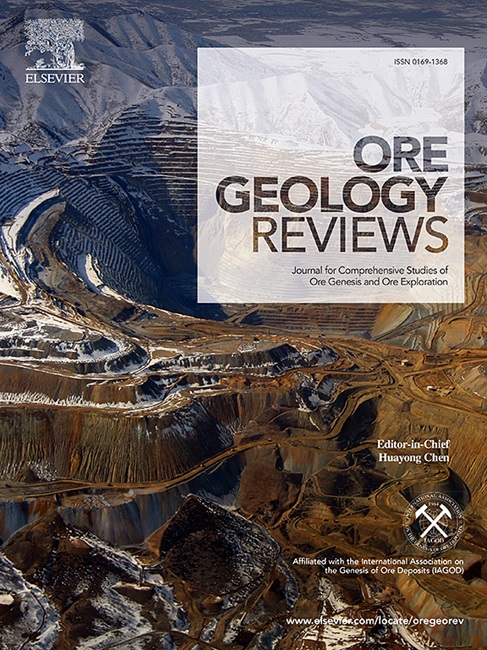Geology and genesis of the Shenshuitan deposit in the Wulonggou gold district, Qinghai Province, China
IF 3.2
2区 地球科学
Q1 GEOLOGY
引用次数: 0
Abstract
The Wulonggou gold district in the Eastern Kunlun region of Qinghai Province, China, hosts several gold deposits, yet the origin and nature of the ore-forming fluids remain debated. This study focuses on the Shenshuitan deposit in the Wulonggou gold district, integrating field observations with petrographic and geochemical analyses to constrain its genesis. Geological observations indicate that the deposit preserves three types alteration (skarn, propylitic and phyllic alteration). LA-ICP-MS U-Pb dating of hydrothermal garnet and magmatic zircon from the mineralization-related quartz diorite porphyry yielded ages of 220 ± 2 Ma and 218 ± 2 Ma, respectively. These overlapping ages indicate a close temporal relationship between magmatism and gold mineralization during the Late Triassic. The close spatial and temporal association among porphyry intrusion, alteration, and mineralization points to a magmatic-hydrothermal origin for the Shenshuitan deposit. The quartz diorite porphyry exhibits adakitic geochemical signatures and εHf(t) values from −6 to −0.9, with two-stage model ages (TDM2) ranging from 0.89 to 1.09 Ga. These features suggest the magma was derived from the partial melting of thickened, juvenile lower crust of Mesoproterozoic age. This magmatic event likely occurred in the post-collisional extensional setting following the closure of the Paleo-Tethys Ocean.

青海省五龙沟金矿区神水滩矿床地质及成因
中国青海省东昆仑地区武龙沟金矿区赋存多处金矿床,但成矿流体的成因和性质仍存在争议。本文以五龙沟金矿区神水滩矿床为研究对象,结合野外观测与岩相、地球化学分析,对其成因进行了限定。地质观测表明,该矿床保存有三种蚀变类型(矽卡岩蚀变、丙岩蚀变和层状蚀变)。矿化相关石英闪长斑岩中热液石榴石和岩浆锆石的LA-ICP-MS U-Pb定年结果分别为220±2 Ma和218±2 Ma。这些年龄的重叠反映了晚三叠世岩浆活动与金矿化的密切时间关系。斑岩侵入、蚀变和成矿的密切时空联系表明,深水滩矿床为岩浆-热液成因。石英闪长斑岩地球化学特征明显,εHf(t)值在−6 ~−0.9之间,两阶段模式年龄(TDM2)在0.89 ~ 1.09 Ga之间。这些特征表明岩浆来源于中元古代增厚的幼年下地壳的部分熔融。这次岩浆活动可能发生在古特提斯洋闭合后的碰撞后伸展环境中。
本文章由计算机程序翻译,如有差异,请以英文原文为准。
求助全文
约1分钟内获得全文
求助全文
来源期刊

Ore Geology Reviews
地学-地质学
CiteScore
6.50
自引率
27.30%
发文量
546
审稿时长
22.9 weeks
期刊介绍:
Ore Geology Reviews aims to familiarize all earth scientists with recent advances in a number of interconnected disciplines related to the study of, and search for, ore deposits. The reviews range from brief to longer contributions, but the journal preferentially publishes manuscripts that fill the niche between the commonly shorter journal articles and the comprehensive book coverages, and thus has a special appeal to many authors and readers.
 求助内容:
求助内容: 应助结果提醒方式:
应助结果提醒方式:


